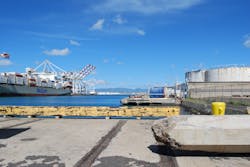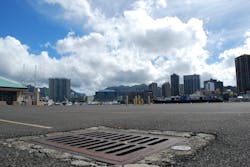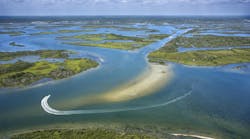Digital stormwater management helps safeguard Hawaii’s coastal ecosystems
Stormwater management is critical for protecting ocean life, especially with increased flooding caused by high tides, storm surges, tsunamis and rising sea levels. When stormwater assets are not well managed, runoff can carry pollutants, sediments and other contaminants into coastal waters.
With its unique geography, Hawaii faces challenges in managing stormwater runoff, such as smaller watershed areas, rugged topography and fragile ecosystems. Because Hawaii’s harbors serve as gateways for commerce, tourism and recreational activities, preserving water quality, mitigating erosion and safeguarding the state’s diverse marine life are critically important but also complex.
Real-time visibility into stormwater assets
In 2014, the Hawaii Department of Transportation (HDOT) entered a consent decree with the U.S. Environmental Protection Agency (EPA) to modernize its stormwater management practices for the Honolulu and Kalaeloa Barber’s Point Harbors.
Moving from manual processes to an asset management system (AMS) was an essential first step toward HDOT doing its part as a steward of the coastal ecosystem adjoining the state’s commercial harbors.
“To make informed decisions, we needed the real-time visibility that we gained from Trimble Cityworks,” said DreanaLee Kalili, Deputy Director for Harbors at HDOT. “After implementing the solution, we were able to take a proactive approach to maintenance activities, mitigating risk and ensuring compliance across the lifecycle of our stormwater assets.”Before implementing the Trimble solution, HDOT needed to map its stormwater infrastructure into a geographic information system (GIS). Working with the Army Corps of Engineers, HDOT mapped every stormwater asset—from inlets, manholes, pipes, above-ground drainage features, post-construction control measures and outfalls—to leases, permits and active construction projects.
The resulting GIS data contained comprehensive information for each asset class, including the type of material, size and condition for pipes, drainage features and outfalls. Data for inlets included type, condition and presence of stencil marking and a schedule for recurring inspection, cleaning, maintenance and repairs. All leases, permits and active construction projects were also loaded into the GIS.
Having centralized asset data in a single system of record enables HDOT to take a proactive approach to asset maintenance, which helps prevent more costly repairs and extends the service life of the assets. As a GIS-centric solution, Trimble Cityworks fully leverages Esri ArcGIS and a platform of web services to provide a reliable, single source of truth to support the effective management of the harbors' municipal stormwater systems.
According to HDOT Harbors’ stormwater managers, the Trimble solution was also instrumental in preventing and/or minimizing stormwater pollution by giving HDOT tools to manage Best Management Practices (BMPs). BMPs in place at harbor construction sites include silt fencing and vegetative buffers, stabilization of construction sites and entrances, management of dirt stockpiles and protection of storm drain inlets. For harbor operations, BMPs include compliance with practices for vehicle and equipment washing and fueling, material delivery and handling, solid and hazardous waste management, outdoor material storage and building remodeling.
Implementation of BMPs required a register of assets under the consent decree. With Trimble Cityworks in place, HDOT had a solution that could tie data on field work and asset maintenance history directly to each asset, facilitating future reporting requirements of the consent decree.Annual awareness and pollution prevention
As part of its stormwater management program, HDOT established annual awareness and pollution prevention training to drive the message of individual responsibility for all lease and permit stakeholders.
“The program improved our relationships with permit stakeholders and community members by increasing regular communication, training and response to service requests,” said Kalili. “Taking a holistic approach to program management and tracking activities in Trimble Cityworks helped us complete the consent decree successfully.”
The Trimble solution formed the central repository for tracking required activities, such as schedules for asset inspection, cleaning, stenciling, maintenance and repair. Work orders are generated in the solution for each necessary task, supporting complete lifecycle management for each storm drain asset.
The complete electronic picture of HDOT Harbor assets helped demonstrate compliance with EPA regulations, with the added benefit of creating preventive maintenance cycles that have expanded the longevity of assets and prevented failures.
“The consent decree contained a lengthy list of requirements that we had to implement and track, from the storm sewer system map to ongoing maintenance and pollution prevention activities,” said Kalili. “Managing such a large volume of data with a paper workflow would have been time-consuming and nearly impossible.”
In February 2022, HDOT Harbors fully satisfied all requirements set forth by the EPA, and the consent decree was lifted. HDOT has since expanded its use of Trimble Cityworks, empowering field crews to complete service requests, work orders, cases and inspections using their mobile devices.
With a single solution for asset management and best practices in place, HDOT is well positioned to preserve the health and integrity of Hawaii's harbors, benefiting both the environment and the communities that rely on these critical coastal resources.




